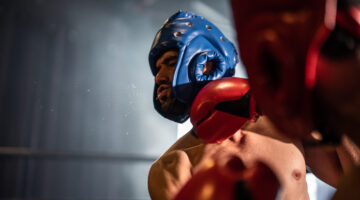For a subsector of health IT that is all about watching almost every move a person makes, privacy is a major talking point of remote patient monitoring. Zeb Kimmel wanted to raise the bar on patient privacy but also wanted to make a monitoring tool that was affordable, wasn’t invasive and didn’t require a wearable that could all too easily be forgotten. He started Atlas5D which uses spatial and depth sensors to promote aging at home and to provide real-time actionable data to caregivers without being invasive. Kimmel, whose company is one of the 128 Mass Challenge finalists, showed me a demo of the monitoring tool it’s developing.
At first glance it resembles a low-fi video game. The avatar — a parent or grandparent resembles the kind of block-like figure you’d expect to find on an Atari video game circa 1982. The screen is divided into hours and each hour shows the no-frills avatar sitting, walking and sitting again and records the duration so that data can be checked. It uses sensors on a tablet placed on a bookshelf. Family or professional caregivers set up alerts which would go off, for example, if mom isn’t up by a certain hour of the morning. The graphics aren’t stunning, but they’re not distracting either. They’re informative and engaging.
“We are very interested in gathering information about how people move in a way that no wearable device can. We want to predict how they are doing.” The device raises the question — by providing alerts, can people intervene earlier to get a better outcome for their loved ones?

The Role of Consultants in Tackling Healthcare Expenses
To ensure effective cost mitigation, employers can’t wait for the market to adjust — they have to punch first.
So far, Kimmel claims it has already saved one life with the device. An investor’s 92-year-old mother — Irene — had the monitoring device in her home. He received an alert to inform him there had been no activity at a time when she should be awake and moving around. The investor contacted a neighbor who had a key. They discovered Irene had suffered a stroke and were able to get her help in time. It was an unexpected opportunity to see the impact of the company’s tool. The investor had no plans to visit his mother when the incident happened but it also gave some peace of mind to Irene because she knew someone would notice her lack of activity. She owned a wearable device to alert caregivers to falls, but she found the device a bit cumbersome and wasn’t wearing it at the time of the stroke.
Although aging in place is a priority, it takes second place to its focus on tracking people with motor disorders.
“Despite modern medicine, we have limited tools to detect how someone is doing in their own home and if you make people wear [a monitor], that is just one more barrier. Our approach is to do that in a way that respects privacy, and still gets measurements over time.”
When the company initially got started it based its technology on Microsoft Kinect software — it even went through Tech Stars’ accelerator backed by Microsoft. In order to make it more affordable, and less invasive, it decided to shift its algorithm from 3D to 2D.
“Kinect technology works incredibly well but because it was bulky, it was tough to find a place to put it in someone’s home.”
Every device has its limitations though. Right now the company is working on how to show more nuanced movement such as when the user stands up and sits down shortly after. Kimmel is also mindful of the need to detect subtle differences in someone’s gait, how fast someone is moving, how they hold their head, or a sudden change in the way the user walks. It is working on developing a way to provide a bird’s eye view of the person in the room without changing the position of the tablet. As a for instance, the demo shows me when he waves with his right hand (still using the no frills avatar) or walks up to a chair to sit down.
“To give a sense of how challenging this technology is to develop, it has to work in a real world environment with people walking in and out of a room, no matter how high or low the device is positioned,” Kimmel said.
Kimmel talks a lot about privacy, which has been so much in the news with NSA revelations. It’s more about a personal philosophy than pointing out any privacy shortcomings in the healthcare industry. “We don’t believe in spying on people and taking people’s personal information and the best defense we have against that is to not have your data at all,” Kimmel said. “I want to mine the data we gather to look for predictive value, but I don’t want to know what you look like.”
He admits his opposition to collecting de-identified data has led to some pushback from potential investors, but he’s happy with the approach the company is taking.
One of the interesting points Kimmel makes is the company’s balance between the value it places on human insight and the effectiveness of artificial intelligence to crunch a lot of data and spot subtle changes over time. One of Kimmel’s four degrees is in computer science with a specialty in artificial intelligence. On the other hand, people are much better than a computer at knowing each others’ habits enough to program alerts when there’s a change.
Atlas5D raises some interesting questions about how much information companies should collect on the patients they monitor and how they use it. But its approach also suggests that by creating more affordable ways to monitor people in their homes it will hugely expand the number of people who can afford access to the technology.
[Photo from Flickr user chase_elliott]








